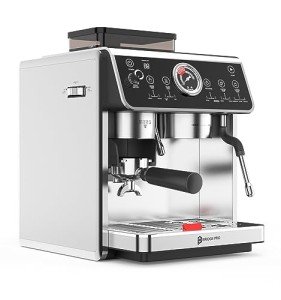Heat Exchange Espresso Machines: A Comprehensive Guide
Espresso machines have developed considerably throughout the years, catering to the needs of home baristas and coffee specialists alike. Among these machines, heat exchange espresso machines have actually gotten appeal due to their ability to provide constant performance and exceptional brew quality. In this article, we will check out the functions, advantages, and essential features of heat exchange espresso machines, offering an extensive understanding for both potential purchasers and coffee lovers.
Understanding Heat Exchange Technology
Heat exchange espresso machines run on a distinct principle that enables synchronised water heating for developing and steaming. They are geared up with a single boiler that uses a heat exchanger system. This function is substantial as it allows users to brew espresso while steaming milk concurrently, promoting effectiveness in the coffee-making process.
How Does a Heat Exchange Espresso Machine Work?
The procedure starts with the machine's water inlet filling the boiler. As the water heats up, it turns to steam. The ingenious heat exchanger uses hot steam to heat additional water in a separate passage created specifically for the brew group. visit the next web site means that water can reach the ideal developing temperature level without waiting for the boiler to adjust. The crucial actions include:
- Water Fill: Water is drawn into the boiler.
- Heating Process: The boiler warms up as water is converted into steam.
- Heat Exchange: Steam heats water in the heat exchanger tube.
- Developing: Water from the heat exchanger is pressed through coffee premises, drawing out the flavors needed for an abundant espresso.
This procedure permits fast temperature level modifications and improved coffee extraction.
Advantages of Heat Exchange Espresso Machines
Heat exchange espresso machines offer a number of advantages, particularly for those wanting to optimize their coffee experience. Here are some key advantages:
- Simultaneous Brewing and Steaming: Users can brew espresso while steaming milk, making it perfect for busy cafes and home baristas who value effectiveness.
- Temperature Stability: The boiler's steam pressure assists maintain a steady temperature, which is critical for constant espresso extraction.
- Versatility: The design enables fast switching between brewing and steaming, making it simpler to develop various coffee beverages, from lattes to cappuccinos.
- User-friendly: Models frequently come with accessible controls, making it practical for both beginners and experienced baristas to produce quality drinks.
- Professional Quality: Heat exchange machines are typically utilized in commercial settings, supplying users with high-quality developing efficiency in your home.
Secret Features to Look for in Heat Exchange Espresso Machines
When thinking about the purchase of a heat exchange espresso machine, there are numerous features that one need to consider:
- Build Quality: Look for machines made from durable materials, such as stainless-steel or brass, ensuring durability.
- Boiler Size: A bigger boiler will hold more water and sustain greater output gradually.
- PID Temperature Control: This function assists keep constant brew temperatures, which can enhance the coffee-making process.
- Group Head Design: Machines with a saturated or semi-saturated group head provide better temperature level stability.
- Relieve of Use: User-friendly interfaces and user-friendly controls boost the general experience for baristas at all skill levels.
- Steam Wand Quality: A good steam wand with proper insulation and flexibility enables much better texturing of milk.
- Water Reservoir Size: Depending on your requirements, consider how typically you want to refill the water tank.
Contrast of Popular Heat Exchange Espresso Machines
To better comprehend the alternatives offered in the market, below is a comparison table of some popular heat exchange espresso machines:
| Machine Model | Boiler Size | PID Control | Cost Range | User Ratings |
|---|---|---|---|---|
| Profitec Pro 700 | 2.0 L | Yes | ₤ 2,000-₤ 2,500 | 9.5/ 10 |
| Rocket Espresso R58 | 1.8 L | Yes | ₤ 2,400-₤ 2,800 | 9.4/ 10 |
| Elekta Bianca | 1.8 L | Yes | ₤ 2,500-₤ 3,000 | 9.6/ 10 |
| La Spaziale S1 Vivaldi II | 1.5 L | Yes | ₤ 1,800-₤ 2,200 | 9.2/ 10 |
| Bezzera Magica | 1.2 L | No | ₤ 1,600-₤ 1,800 | 9.0/ 10 |
FAQs About Heat Exchange Espresso Machines
What is the main difference in between a heat exchange and a dual boiler espresso machine?
While both types can brew espresso and steam milk at the same time, dual boiler machines have different boilers for developing and steaming. In contrast, heat exchange machines make use of a single boiler and a heat exchanger to accomplish the very same function.
Are heat exchange machines appropriate for beginners?
Yes! Numerous heat exchange machines are designed with user-friendly functions, making them available for newbies. With correct guidance and practice, users can rapidly produce quality espresso.
What type of upkeep do heat exchange espresso machines require?
Routine upkeep consists of descaling, cleaning up the boiler, checking seals and gaskets, and keeping the group head clean. Regular maintenance guarantees durability and constant efficiency.
Can I use a heat exchange machine for different kinds of coffee drinks?
Definitely! visit the up coming post allow users to develop a range of coffee drinks, consisting of espresso, lattes, coffees, and more.
Heat exchange espresso machines represent a mix of innovation and custom, supplying coffee enthusiasts with the tools needed for crafting the perfect cup. Their capability to simultaneously brew and steam, combined with precise temperature level control, makes them an engaging choice for both home baristas and experts. With the ideal knowledge on features and maintenance, users can unlock a world of beautiful coffee experiences, making sure that each sip is as delightful as the last.

